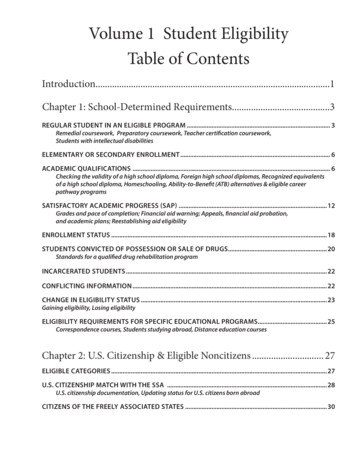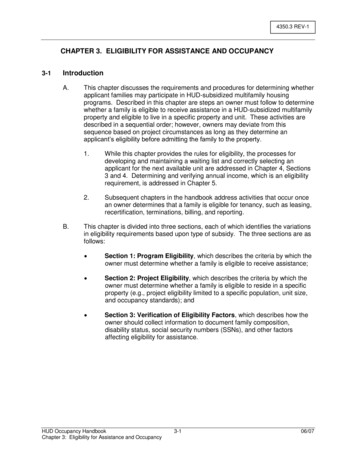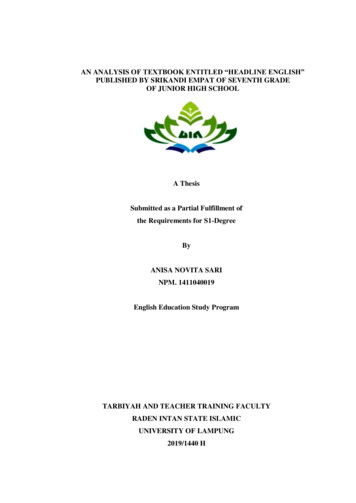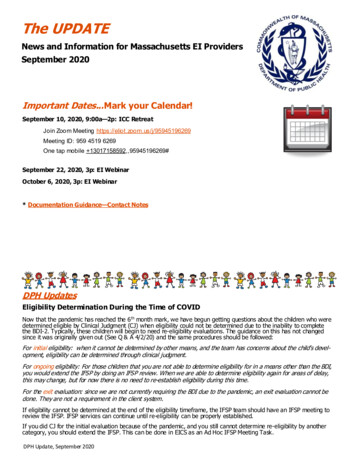
Transcription
Volume 1 Student EligibilityTable of ContentsIntroduction.1Chapter 1: School-Determined Requirements.3REGULAR STUDENT IN AN ELIGIBLE PROGRAM. 3Remedial coursework, Preparatory coursework, Teacher certification coursework,Students with intellectual disabilitiesELEMENTARY OR SECONDARY ENROLLMENT. 6ACADEMIC QUALIFICATIONS . 6Checking the validity of a high school diploma, Foreign high school diplomas, Recognized equivalentsof a high school diploma, Homeschooling, Ability-to-Benefit (ATB) alternatives & eligible careerpathway programsSATISFACTORY ACADEMIC PROGRESS (SAP). 12Grades and pace of completion; Financial aid warning; Appeals, financial aid probation,and academic plans; Reestablishing aid eligibilityENROLLMENT STATUS. 18STUDENTS CONVICTED OF POSSESSION OR SALE OF DRUGS. 20Standards for a qualified drug rehabilitation programINCARCERATED STUDENTS. 22CONFLICTING INFORMATION. 22CHANGE IN ELIGIBILITY STATUS. 23Gaining eligibility, Losing eligibilityELIGIBILITY REQUIREMENTS FOR SPECIFIC EDUCATIONAL PROGRAMS. 25Correspondence courses, Students studying abroad, Distance education coursesChapter 2: U.S. Citizenship & Eligible Noncitizens. 27ELIGIBLE CATEGORIES. 27U.S. CITIZENSHIP MATCH WITH THE SSA . 28U.S. citizenship documentation, Updating status for U.S. citizens born abroadCITIZENS OF THE FREELY ASSOCIATED STATES. 30
ELIGIBLE NONCITIZEN MATCH WITH THE DHS. 31ARN corrections and additions to the FAFSATHIRD STEP VERIFICATION (FORMERLY FORM G-845). 33Third step verification preparation, Third step verification via the SAVE system, Eligible noncitizensand documentation, Jay Treaty, Ineligible statuses and documentsELIGIBLE NONCITIZENS AND DOCUMENTATION.34USING THE SAVE SYSTEM FOR THIRD STEP VERIFICATION. 42SAVE third step responses, Interpreting the SAVE response, Student rightsDOCUMENTING IMMIGRATION STATUS IN LATER AWARD YEARS. 47REPLACING LOST DHS DOCUMENTS. 48EXAMPLES OF U.S. CITIZENSHIP AND ELIGIBLE NONCITIZEN DOCUMENTS. 48Chapter 3: NSLDS Financial Aid History. 55NSLDS MATCH. 56Successful match, No data from match, Postscreening, Unusual enrollment history (UEH), Documentingcredits earned when a school has closedCHECKING THE FINANCIAL AID HISTORYFOR TRANSFER STUDENTS.61EFFECT OF BANKRUPTCY OR DISABILITY DISCHARGE. 63Bankruptcy, Total and permanent disability (TPD) dischargesRESOLVING DEFAULT STATUS. 64NSLDS LOAN STATUS CODES. 65Chapter 4: Social Security Number. 67SOCIAL SECURITY NUMBER (SSN) MATCH. 67Successful match, No match on the Social Security number,No match on name or birth date, Missing information, Date of deathDEATH MASTER FILE.70APPLICANTS USING SAME SSN. 70EXCEPTION FOR THE FREELY ASSOCIATED STATES: MICRONESIA,MARSHALL ISLANDS, AND PALAU. 71
Chapter 5: Selective Service. 73REGISTRATION REQUIREMENT. 73EXEMPTIONS. 73SELECTIVE SERVICE MATCH.75Successful matches, Unsuccessful matchesFAILURE TO REGISTER.76Determining if non-registration was knowing and willfulChapter 6: Eligibility for Specific FSA Programs. 79FEDERAL PELL GRANTS. 79Incarcerated students and sex offenders, Duration of eligibility,Eligible postbaccalaureate program, Restoring semesters of Pell eligibility for students affected byclosed schoolsIRAQ AND AFGHANISTAN SERVICE GRANTS & ZERO EFCS. 82DIRECT LOANS. 82Preparatory coursework, Teacher certification coursework, Parent borrower eligibility,Subsidized Loan Eligibility Time Limitation (150% rule), Adverse credit history for Direct PLUS,CAMPUS-BASED AID GENERAL REQUIREMENTS. 85Teacher certification programsPERKINS LOANS. 86FEDERAL WORK-STUDY (FWS). 86FSEOG . 86TEACH GRANTS. 87Amount of grant funds available, Receiving a TEACH grant, Agreement to serve,Schools without a traditional GPA
iIntroductionThis volume of the Federal Student Aid (FSA) Handbook discusses the eligibilityrequirements for students and parent borrowers and your responsibilities to ensure that recipients qualify for their aid awards.SOURCES OF INFORMATIONThere are many factors you must consider when reviewing an applicationfor aid from the FSA programs, such as whether the student is a U.S. citizen or permanent resident, whether the applicant is making satisfactory academic progress, and whether he or she has a defaulted FSA loan. To answerthese questions you receive information about the student from differentsources, including the Department of Education’s Central Processing System(CPS) for financial aid applications and the National Student Loan Data System (NSLDS).Throughout the year, the Department of Education (The Department)provides updates to schools in the form of Dear Colleague Letters (DCLs).These and other releases, such as Federal Register notices and electronic announcements containing system updates and technical guidance, are available on the Information for Financial Aid Professionals (IFAP) website(ifap.ed.gov).The FSA Handbook does not cover the operation of software. Forschools using software from the Department, there are technical referenceson IFAP that explain how the software operates. Schools using third-partysoftware should consult the vendor’s reference materials for technical guidance.RECENT CHANGESHere are some of the significant changes to Volume 1 for 2019-2020:Program and systemsinformation onlineIFAP’s Software & Other ToolsSoftware: Direct Loan Tools EDconnect EDExpress for Windows SSCR for WindowsTechnical References and UserGuides for: CPS (ISIR, Summary of Changes, etc.) COD Electronic Data Exchange EDExpress Packaging Federal Registers Electronic Announcements Dear Partner/Colleague Letters FSA Assessment modules:Student tudentEligibility20182019.htmlSatisfactory Academic Progress AcademicProgress20182019.htmlChapter 1: Sidebar on the timing of eligibility for Ability-To-Benefit (ATB) Alternatives & Eligible Career Pathway programs (ECPP) added. ATB options and Eligible Career Pathways Programs sidebar updated with revised citations.FSA HB Jul 20191–1
Vol. 1—Student Eligibility 2019–20 SAP prohibited practices FAQ added.Chapter 2: Expanded guidance in “citizenship issues” sidebar. Description/requirements for eligible noncitizens categories updated: Lawful Permanent Residents (LPRs), Parolees, and BatteredImmigrants qualified aliens.FSA CoachANN-13-21FSA Coach, a self-paced, comprehensiveonline guide to the Title IV programs,has been updated for domestic schools.For more information, see:https://ifap.ed.gov/ifap/fsacoach.jspCOACH for foreign schools will be updated in the future; monitor IFAP forforthcoming training announcements. and expanded. Revised guidance in “Using the SAVE system for third-step verification” section. Updated “Interpreting the SAVE response” section. “Requesting a new DHS verification number” sidebar renamed “Resend record to matches process” and new process described. New U.S. citizenship and eligible noncitizens documents examplesadded.Questions or comments?If you have any comments regardingthe FSA Handbook, please contactResearch and Publications via email atfsaschoolspubs@ed.gov.“Using the SAVE system for third-step verification” section revisedChapter 3: Updated chapter throughout for the wind down of the Perkins Loanprogram.Chapter 6:1–2 Added new Children of Fallen Heroes Scholarship Act sidebar.Eligibility for children of fallen heroes described, citations to lawand E-Announcement added. Revised Perkins wind down sidebar with updated citations. Perkins guidance deleted. No Perkins disbursements of any type arepermitted under any circumstances after June 30, 2018. Loans awarded or disbursed after authority expired subsectionadded.FSA HB Jul 2019
1In this chapter, we discuss student eligibility requirements that don’t require information fromthe Department’s systems. The school determines on its own whether the student meets theseeligibility requirements. In some cases, the financial aid office will need to get information fromother school offices, such as the admissions office or the registrar, or from other organizations,such as high schools or testing agencies.REGULAR STUDENT IN AN ELIGIBLE PROGRAMAperson must be enrolled as a regular student in an eligible program toreceive Federal Student Aid (FSA) funds (exceptions are discussed laterin this chapter). A regular student is someone who is enrolled or accepted forenrollment in an eligible institution for the purpose of obtaining a degree orcertificate offered by the school. The requirement for an eligible program isdiscussed in Volume 2, Chapter 2.A school must document a student’s enrollment in an eligible programat the time of admission, and it must have a system to notify the financial aidoffice if the student leaves the program. It must also document that an aidrecipient is a regular student. Conditional acceptance. Some schools admit students provisionally,for example, until they provide further documentation, such as academictranscripts or test scores, or demonstrate an ability to succeed in the programby receiving acceptable grades in program coursework. Typically, theschool will limit these students’ enrollment in terms of number of courses orenrollment status until they meet the necessary conditions.Students admitted as conditional are regular students only if the schoolofficially accepts them into the eligible degree or certificate program. TheDepartment does not define official acceptance or admission. If the studentis merely allowed to take some courses before being officially admitted to theprogram, she is not considered a regular student and is not eligible for FSAfunds until she is officially admitted.Student eligibility34 CFR 668.32See Volume 2, Chapter 2 for eligibleprogram requirements.Regular student exampleHEA Sec. 484(a)(1), (b)(3), (4);34 CFR 668.32(a)(1)34 CFR 668.24(c)(iii)Northside Community College (NSCC)allows anyone with a high schooldiploma or the equivalent to enroll inany course. Many of NSCC’s studentsdo not intend to receive a degree orcertificate; they are not regular students.NSCC requires those who want toreceive a degree or certificate tocomplete a form stating which degreeor certificate they are studying for andto meet periodically with an academicadvisor. NSCC considers them to beregular students.Schools may offer a trial or conditional period during which a student attends a program without incurring program charges or receiving FSA funds.If the student continues beyond the trial period and enrolls as a regular student, the school can pay him FSA grants for the entire payment period andloans for the period of enrollment. See Dear Colleague Letter GEN-11-12 formore information.FSA HB Jul 20191–3
GlossaryVolume 1—Student Eligibility 2019–20Conditional acceptanceexamples1. Waveland University allows studentsto take graduate courses before theyhave taken the GRE, but it limits themto no more than three courses anddoes not admit them into its graduateprograms until they have submittedacceptable GRE scores. They aren’tregular students, and since the schoolhasn’t admitted them, they aren’teligible for FSA funds.2. When Wrigley University acceptsstudents into its graduate programs, itrequires that the students receive nograde lower than a “B” in the first threecourses. During this time, the schoolconsiders students to be admittedinto the program, so they are eligiblefor FSA. If, however, students receivea grade lower than a B in any of thefirst three classes, their admittance willbe withdrawn and they then will beineligible for further FSA funds.Continuing education examples1. Sheffield University has a continuingeducation department that offers manyonline (telecommunications) coursesthat students in other departments ofthe school may take and that apply tothe degree or certificate program inwhich the students are enrolled. Theseare regular students who are eligible forFSA funds.2. Windy City University has acontinuing education department thatoffers many courses. Some studentsenroll in these courses without beingadmitted to the university. They are notregular students and are not eligible forFSA funds.Remedial coursework34 CFR 668.201–4CFRDCL Continuing education. Regular students may receive aid for classesthey take in a school’s continuing education department as long as the classesapply to their degree or certificate program.Remedial courseworkRemedial coursework prepares a student for study at the postsecondarylevel (as opposed to preparatory coursework, which prepares a studentfor a given program). A student enrolled solely in a remedial program isnot considered to be in an eligible program. If acceptance into an eligibleprogram is contingent on completing remedial work, a student cannot beconsidered enrolled in that program until she completes the remedial work.However, if the student is admitted into an eligible program and takesremedial coursework within that program, he can be considered a regularstudent, even if he is taking all remedial courses before taking any regularcourses. You may count up to one academic year’s worth of these coursesin his enrollment status for federal aid. For the purpose of this limit, that is30 semester or trimester hours, 45 quarter hours, or 900 clock hours. If theremedial classes are non-credit or reduced-credit, you must determine howmany credit hours they are worth to count toward the student’s enrollmentstatus (see “Enrollment status” section in this chapter).A remedial course cannot be below the educational level needed for astudent to successfully pursue her program after one year in that course.Also, remedial courses must be at least at the high school level, as determinedby the state legal authority, your school’s accrediting agency, or the stateagency recognized for approving public postsecondary vocational education.If that agency determines that a remedial class is at the elementary level, theschool must abide by that determination, and the class cannot be includedfor FSA purposes. Nor can FSA funds be used for a remedial course that usesdirect assessment of student learning instead of credit or clock hours.You cannot use non-credit remedial hours to determine a student’senrollment status if the course is part of a program that leads to a high schooldiploma or its recognized equivalent. A student is never permitted to receivefunds for training or for coursework prior to the completion of high school,even if the high school equivalency training is offered at postsecondaryschools or is required for the postsecondary program.Similar to other remedial coursework, a student may receive FSA fundsfor English as a second language (ESL) courses that are part of a larger eligible program. There are differences though: ESL courses don’t count againstthe one-year limitation on remedial coursework, and they need not be at thesecondary school level.If your school permits a student to enroll in ESL or other remedialcourses that don’t apply to his degree or certificate, be aware that awardingFSA loans or Pell Grants over a series of semesters for such work can exhausthis eligibility for Pell Grants and/or FSA loans before he completes his program.FSA HB Jul 2019
GlossaryCFRDCLChapter 1—School-Determined RequirementsPreparatory courseworkA student not enrolled in a degree or certificate program is eligible forDirect Subsidized/Unsubsidized Loans (and a parent may receive DirectPLUS Loans on behalf of a dependent student) for up to one year if she istaking coursework necessary for enrollment in an eligible program. See thediscussion under Direct Loans in Chapter 6 of this volume.Teacher certification courseworkA student may receive Federal Work-Study (FWS), as well as DirectSubsidized/Unsubsidized Loans (and a parent may receive Direct PLUSLoans on behalf of a dependent student) if he or she is enrolled at least halftime in required teacher certification coursework, even if it does not lead to adegree or certificate awarded by the school. For more details on Direct Loaneligibility criteria, see Chapter 6 of this volume.Teacher certification coursework34 CFR 668.32(a)(1)(iii)DCL GEN-16-10HEA Sec. 484(b)(4)HEA Sec. 401(c)(4)(B)To qualify, the coursework must be required for elementary or secondaryteacher certification or recertification in the state where the student plansto teach and must be offered in credit or clock hours. Courses using directassessment in lieu of credit or clock hours are not eligible. An otherwiseeligible student may also receive a TEACH Grant. Optional courses thatthe student elects to take for professional recognition or advancement, andcourses recommended by your school but not required for certification, donot qualify. You should document that the courses are required by the statefor teacher certification.A student with a bachelor’s degree who is enrolled in a postbaccalaureateteacher certification program can receive a Pell Grant in limited situations.See Chapter 6 of this volume.Students with intellectual disabilitiesStudents with an intellectual disability (see margin note) can receivefunds from the Pell Grant, FSEOG, and FWS programs. They must be enrolled or accepted for enrollment in a comprehensive transition and postsecondary program (as defined in 34 CFR 668.231) for students with intellectualdisabilities and must maintain satisfactory academic progress as determinedby the school for this program. These students: do not have to be enrolled for the purpose of obtaining a degree orcertificate, and are not required to have a high school diploma or its recognizedequivalent.Except for the statutes governing need analysis, the Secretary has theauthority to waive any Pell Grant, FSEOG, FWS, or institutional eligibilityprovisions necessary to ensure that programs enrolling students with intellectual disabilities are eligible for these three types of federal student aid and thateligible students receive those funds.FSA HB Jul 2019Students with intellectualdisabilitiesHEA Sec. 484(s)34 CFR 668.230–23320 U.S.C. 1091, 1140Students who:1) have mental retardation or acognitive impairment characterizedby significant limitations in intellectualand cognitive functioning and adaptivebehavior as expressed in conceptual,social, and practical adaptive skills; and(2) are currently or were formerlyeligible for special education andrelated services under the Individualswith Disabilities Education Act (IDEA)(20 U.S.C. 1401), including students whowere determined eligible for specialeducation or related services underthe IDEA but were homeschooled orattended private school.See 668.233(c) for documentationrequirements.1–5
GlossaryVolume 1—Student Eligibility 2019–20Elementary/secondaryenrollmentHEA Sec. 484(a)(1)34 CFR 668.32(b)Secondary school enrollmentexamplesMarie is a junior in high school andenrolls in an electronics technicianprogram at Lakeshore CommunityCollege (she is above the age ofcompulsory school attendance for herstate and therefore can be admitted asa regular student). The coursework isoffered evenings and weekends, so shecan still attend her high school classes.The electronics technician program isan eligible postsecondary program,and Marie will receive a certificate fromLakeshore when she completes theprogram. However, she is not eligiblefor aid because she is still enrolled inhigh school.Joe, a regular student at WavelandUniversity, decides to take a driver’seducation course at the local highschool during the summer. This doesnot mean he is enrolled in secondaryschool.Graduate or professionalstudent definition34 CFR 668.2(b)For Title IV student eligibility purposes, agraduate or professional student is definedas a student who is enrolled in a program orcourse above the baccalaureate level or ina professional program and has completedthe equivalent of three academic years offull-time study, either prior to entering theprogram or as part of the program itself.Also, a student who is receiving Title IV aidas an undergraduate student cannot beconsidered a graduate/professional studentfor that same period of enrollment.1–6DCLELEMENTARY OR SECONDARY ENROLLMENTA student enrolled in elementary or secondary school is not eligiblefor aid from the FSA programs, even if she is simultaneously enrolled in aneligible college program. A student is considered to be enrolled in secondaryschool if she is pursuing a high school diploma or if she has completed therequirements for a diploma, has not yet received it, and either she is takingcollege coursework for which her high school gives credit or her high schoolstill considers her to be enrolled there.An adult pursuing a high school equivalency certificate (not a highschool diploma) is not considered to be enrolled in secondary school.However, as stated earlier, a student cannot get aid for high schoolequivalency training. An adult can take a course offered by a high school,such as a driver’s education course, without being considered enrolled there.ACADEMIC QUALIFICATIONSTo receive FSA funds, a student must be qualified to study at thepostsecondary level. A student qualifies if she: has a high school diploma (this can be from a foreign school if it isequivalent to a U.S. high school diploma); has the recognized equivalent of a high school diploma, such as ageneral educational development (GED) certificate or other statesanctioned test or diploma-equivalency certificate; has completed homeschooling at the secondary level as defined bystate law; has completed secondary school education in a homeschool setting which qualifies for an exemption from compulsory attendancerequirements under state law, if state law does not require a homeschooled student to receive a credential for their education; or has completed one of the ability-to-benefit (ATB) alternatives andis either currently enrolled in an eligible career pathway program orfirst enrolled in an eligible postsecondary program prior to July 1,2012.Academic qualificationsHEA Sec. 484(d)34 CFR 668.32(e)COD Technical ReferenceCFRA student may self-certify on the FAFSA that he has received a highschool diploma or high school equivalency certificate or that he has completed secondary school through homeschooling as defined by state law. If astudent indicates that he has a diploma or high school equivalency certificate,your school isn’t required to ask for a copy (except as noted below), but ifyour school requires a diploma for admission, then you must rely on thatcopy of the diploma or high school equivalency certificate and not on the student’s certification alone.Awards submitted to the Common Origination and Disbursement(COD) system for all students require a Student Eligibility Code (previouslyAbility to Benefit Code) to report how the student (including graduate andFSA HB Jul 2019
GlossaryCFRDCLChapter 1—School-Determined Requirementsprofessional students) is qualified to study at the postsecondary level (e.g.by obtaining a high school diploma or its recognized equivalent). For moredetail on submitting the appropriate Student Eligibility Code, see the CODTechnical Reference on IFAP.Checking the validity of a high school diplomaIf your school or the Department has reason to believe that the highschool diploma is not valid or was not obtained from an entity that providessecondary school education, you must evaluate the validity of the student’shigh school completion.Students who indicate on their FAFSA that they graduated high schoolmust give the name, city, and state of the high school. FAFSA on the Webwill not allow students to skip these items, and it will have a drop-down listof both public and private high schools populated by the National Centerfor Education Statistics (NCES). Inclusion on the list does not mean that adiploma from the school is valid, nor does exclusion from the list mean thatthe diploma is invalid. Acceptable documentation for checking the validity ofa student’s high school completion can include the diploma and a final transcript that shows all the courses the student took.Diplomas from unaccredited high schools can be valid and qualify students to receive FSA funds, as well as to meet college admission standards.One resource that a school may consider to determine if a high school diploma is valid is the department of education in the state in which the highschool is located, if that department has jurisdiction over the high school.Colleges are also free to consult with each other as they develop their procedures for checking the validity of high school diplomas. For students whocompleted their secondary schooling outside the United States, comparabledocuments can help, as can the services of companies that determine the validity of foreign secondary school credentials.A student’s self-certification is not sufficient to validate a high schooldiploma that is in question. If there is conflicting information between thestudent’s certification on the FAFSA and other documentation or information obtained from the student, the institution must resolve this conflict. Foran institution to be a Title IV eligible institution, it must admit as regularstudents only those with a high school diploma or the recognized equivalentand/or those who are beyond the age of compulsory school attendance in theState where
Preparatory coursework, Teacher certification coursework, Parent borrower eligibility, Subsidized Loan Eligibility Time Limitation (150% rule), Adverse credit history for Direct PLUS, CAMPUS-BASED AID GENERAL REQUIREMENTS










